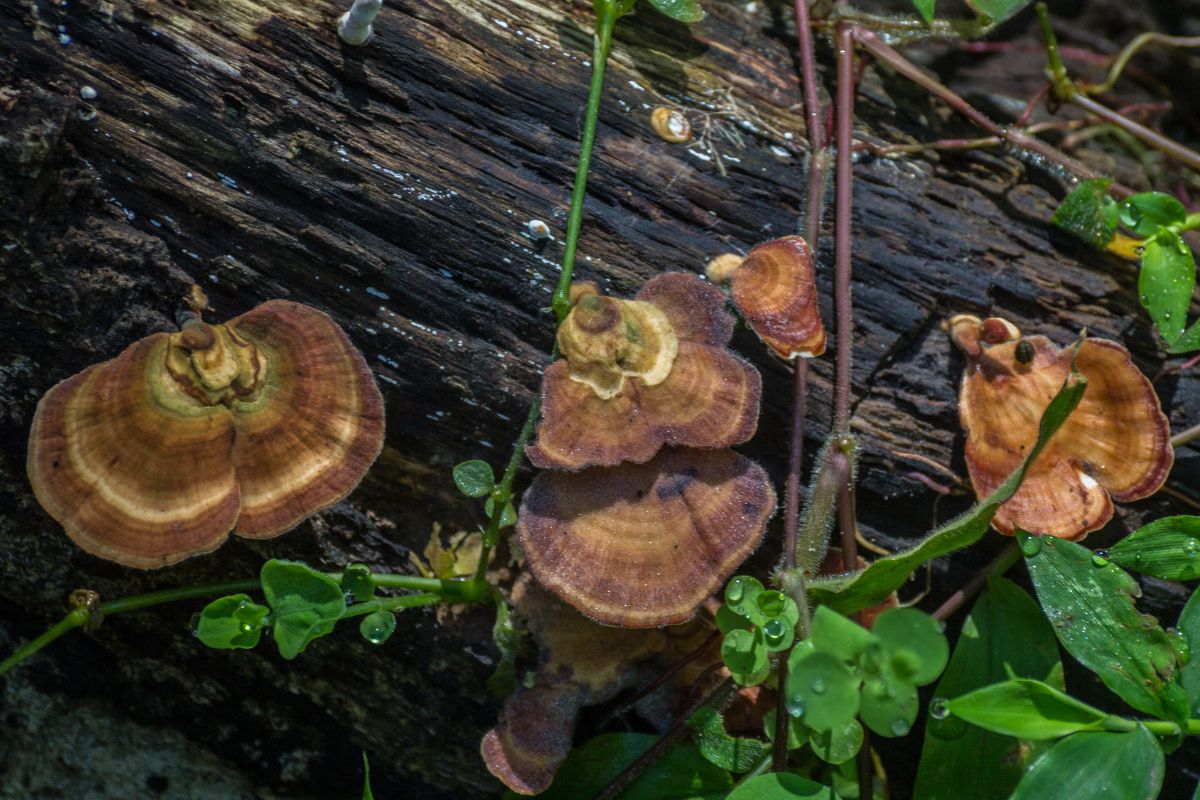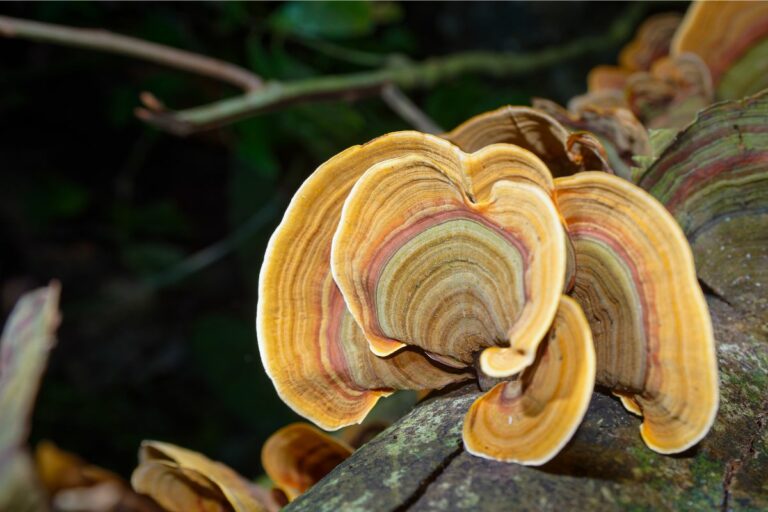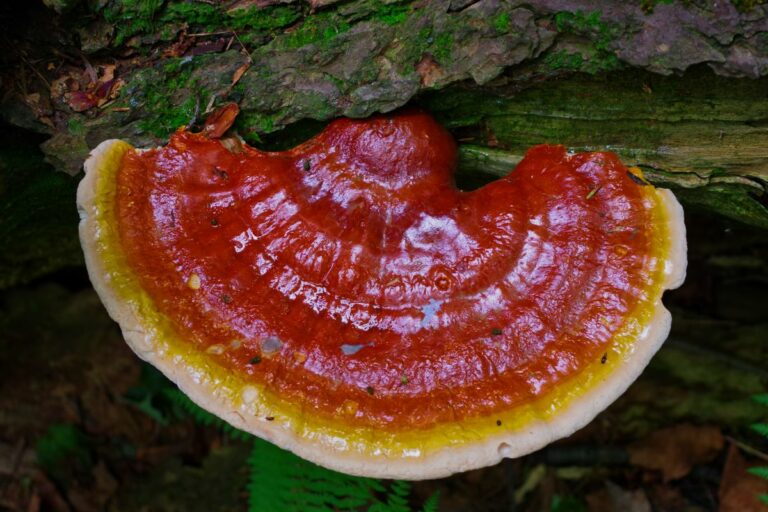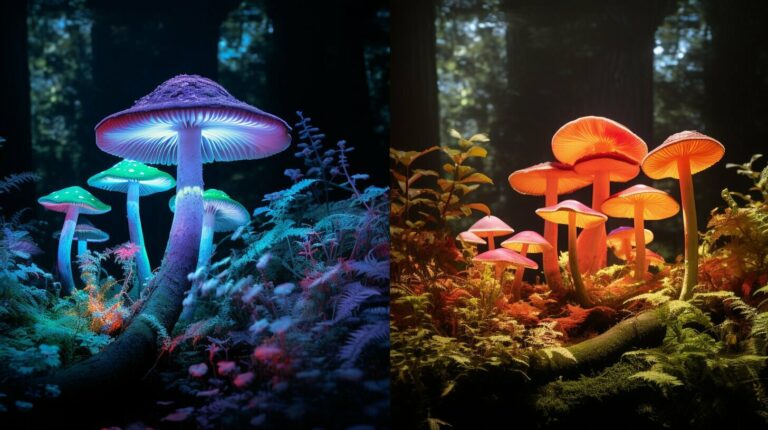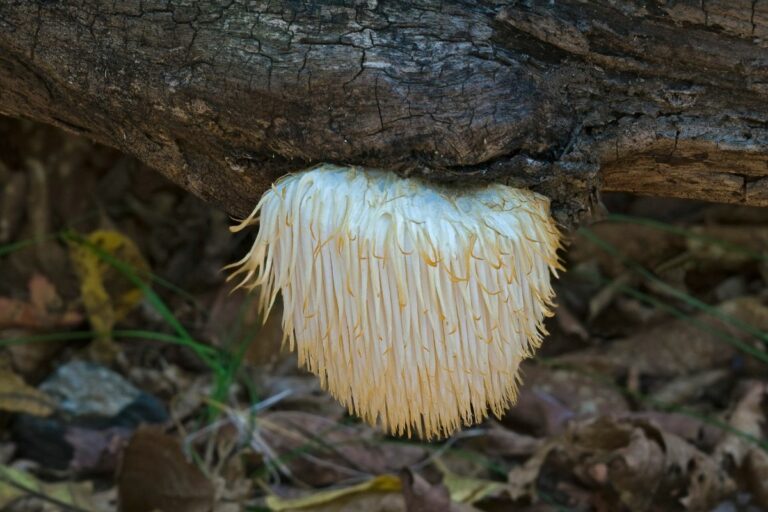Turkey tail mushrooms, scientifically known as Trametes versicolor, are a common type of fungi found on decaying wood in forests worldwide. They are known for their medicinal properties and unique, colorful fan-like appearance resembling the tail of a wild turkey. Being able to correctly identify these mushrooms is essential not only for the harvesting purposes but also to avoid confusion with other inedible or toxic species.
The distinctive features of turkey tail mushrooms include their multi-colored concentric bands, varying from shades of brown to blue and white. They commonly grow in shelf-like clusters, with individual mushrooms measuring between 2 to 10 centimeters in width. One essential aspect in the identification process is observing the underside of these mushrooms, which should reveal tiny, closely-spaced pores instead of gills or teeth.
In addition to physical characteristics, it’s crucial to understand the specific habitat and environmental conditions that favor turkey tail growth. These mushrooms thrive on decomposing hardwood, such as fallen branches, logs, or tree stumps. They can be found year-round but are most commonly encountered in the fall months when the humidity is higher and temperatures are cooler.
Turkey Tail Mushroom Fundamentals
Table of Contents
| Attribute | Description |
|---|---|
| Botanical Name | Trametes versicolor |
| Common Names | Turkey Tail Mushroom, Coriolus versicolor, Yun-zhi (in traditional Chinese medicine) |
| Family | Polyporaceae |
| Habitat and Distribution | Commonly found on dead or fallen hardwood trees and logs worldwide, including North America and Europe. |
| Appearance | Typically has concentric circles of various colors, resembling turkey tail feathers. |
| Traditional Uses | Utilized for centuries in traditional Chinese medicine and other cultures for its potential health benefits. |
| Active Compounds | Polysaccharopeptides (PSP), beta-glucans, lectins, and other bioactive compounds. |
| Health Benefits | – Immune system support <br> – Potential anti-cancer properties <br> – Antioxidant and anti-inflammatory effects <br> – Gut health support <br> – Potential benefits for liver health |
| Preparation | Available as dried mushrooms, extracts, capsules, and powders for consumption as supplements. |
| Dosage | Dosage may vary depending on the form and individual needs. Typically 1 to 3 grams of dried mushroom or following product instructions for extracts and capsules. |
| Safety | Generally considered safe when used as directed. Consult with a healthcare professional if pregnant, nursing, or taking medications. |
| Potential Side Effects | Rare, but can include mild gastrointestinal symptoms in some individuals. |
| Interactions | May interact with certain medications, including immunosuppressants. Consult with a healthcare provider if taking medication. |
| Legal Status | Widely available as a dietary supplement and herbal remedy. |
| Research | Ongoing studies explore its potential health benefits, particularly its role in immune support and cancer treatment. |
The turkey tail mushroom, also known by its scientific name Trametes versicolor, is a widely recognized and highly sought-after polypore mushroom known for its medicinal properties as well as its distinct appearance. This type of mushroom grows predominantly on decaying wood, which plays a crucial role in nutrient cycling within ecosystems.
When identifying turkey tail mushrooms, one should pay close attention to their key features. One of the most distinctive characteristics of this mushroom is its colorful, concentric, fan-like bands that resemble the tail feathers of a turkey. These bands are often comprised of shades of brown, gray, and bluish-green, which can vary depending on environmental factors and age.
The texture of turkey tail mushrooms is another important aspect to consider. The upper surface of the fruiting body is typically covered in a fine, velvet-like fuzz, which distinguishes it from other similar-looking fungi. The mushroom is also quite flexible, even though it might appear tough at first glance.
Examining the underside of the turkey tail mushroom is essential for identification purposes, as it lacks the gills commonly found in many other mushrooms. Instead, the turkey tail mushroom displays tiny, tightly-packed pores that are usually white or off-white in color. These pores release spores, which allow the fungus to reproduce and spread throughout its environment.
In summary, turkey tail mushrooms can be readily identified by their unique appearance, characterized by their fan-like bands, velvety texture, flexible nature, and distinct pore structure. Keeping these features in mind will help in accurately distinguishing Trametes versicolor from other polypore mushrooms that may be encountered in the wild.
Turkey Tail Mushroom Identification
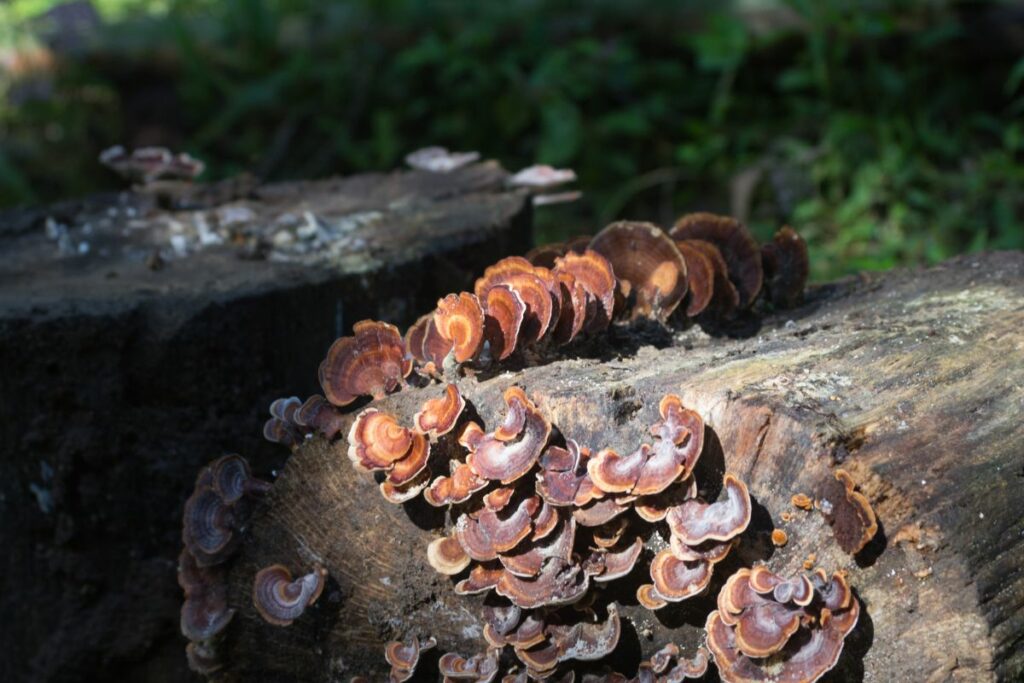
When foraging for mushrooms, proper identification is crucial for safety and success. Turkey tail mushrooms are a popular species for their potential medicinal benefits. To correctly identify turkey tail mushrooms, pay attention to the following characteristics.
- Firstly, observe the size and shape of the mushroom. Turkey tail mushrooms are relatively small, with a diameter between 2 to 10 centimeters. They are typically semi-circular or fan-shaped and grow in overlapping clusters on dead logs or tree stumps.
- Next, examine the texture and appearance of the mushroom’s upper surface. Turkey tail mushrooms have a velvety or slightly fuzzy texture. Their most distinctive feature is the presence of color zones, ranging from shades of brown, gray, and cream to blue or green. The colors often form concentric bands, giving the appearance of the tail feathers of a turkey, hence the name.
- Flip the mushroom over to check the pore surface on the underside. A genuine turkey tail mushroom will have small pores, measuring between 1 to 4 millimeters, arranged in a tight pattern. The coloring of the pore surface can vary from white to yellowish or brownish, sometimes changing as the mushroom ages or depending on environmental conditions.
- Lastly, test the flexibility of the mushroom. Turkey tail mushrooms are known to be slightly flexible and leathery in texture as opposed to being brittle or easily breaking. This characteristic can help distinguish them from similar-looking species.
In conclusion, by carefully examining the size, shape, texture, color zones, pore surface, and flexibility of a mushroom, you can confidently identify a turkey tail mushroom and safely enjoy your foraging experience.
False Turkey Tail Mushroom
The False Turkey Tail mushroom, also known as Stereum ostrea, is a commonly mistaken look-alike of the genuine Turkey Tail mushroom, Trametes versicolor. Although False Turkey Tail and Turkey Tail may appear incredibly similar, especially from above, there are some key differences to be aware of when looking to identify these mushrooms confidently and accurately.
- One of the primary distinguishing features between the two fungi is their texture. The False Turkey Tail mushroom has a smooth surface, while the real Turkey Tail has a more porous underside that resembles a polypore. This structural difference is a crucial telltale sign to differentiate between the two in the wild.
- Another characteristic that can help in distinguishing the False Turkey Tail from the real Turkey Tail is their color patterns. Stereum ostrea, or False Turkey Tail, usually has a more uniform color, whereas Trametes versicolor displays a wider range of colors, creating a more vibrant, multicolored appearance. However, keep in mind that color variations can be subtle and might not always be reliable for identification purposes.
- Finally, it is essential to consider the growth pattern of these mushrooms when trying to identify them. Both the real and False Turkey Tails can be found growing on dead or decaying wood, often in fan-shaped clusters. However, the real Turkey Tail exhibits a more distinctly zoned and banded pattern on its upper surface, which may help differentiate it from the False Turkey Tail.
Understanding these distinctions between the False Turkey Tail mushroom and the genuine Turkey Tail will help foragers and mushroom enthusiasts to identify and appreciate these fungi correctly. Remember to always exercise caution and consult reliable sources if unsure of mushroom identification.
Identifying Look-alikes
When it comes to identifying turkey tail mushrooms, it’s important to be aware of their various look-alikes that can be easily mistaken for the real thing. While turkey tail mushrooms are generally considered safe to consume, some of their look-alikes may be inedible or toxic, making accurate identification crucial.
One common look-alike is Trichaptum biforme, also known as the violet toothed polypore. This mushroom closely resembles turkey tail due to its similar shape and color, but its underside displays a distinct violet or purple hue. Examining the underside of the mushroom can help distinguish between these two species, as turkey tail features white to light brown pores, whereas violet toothed polypore displays violet or purple tooth-like structures.
Another look-alike to be mindful of is crust fungus such as Stereum hirstum, which shares a similar appearance with turkey tail but possesses a smooth underside without any visible pores or teeth. This fungus can often grow on the same types of wood as turkey tail, making it easy to mistake the two. Paying attention to the mushroom’s underside is again crucial in differentiating between the two.
Trichaptum abietinum, a relative of Trichaptum biforme, is another potential look-alike. Although the shape of Trichaptum abietinum differs slightly, its coloration and appearance can lead to confusion. Once again, closely examining the underside will reveal the telltale differences, as the tooth-like structures in this species appear white to gray rather than violet or purple.
When comparing turkey tail mushrooms to look-alikes, one key aspect to focus on is their color zones. Turkey tail mushrooms have distinct, alternating bands of color, typically in shades of brown and tan. If a mushroom lacks these clearly defined color zones, it is likely not a true turkey tail.
Finally, although there are no known toxic lookalikes for turkey tail mushrooms, it is still important to exercise caution and make a thorough identification, as misidentifying any wild mushroom can lead to potential risks. By observing the factors discussed above, such as color zones and identifying structures on the mushroom’s underside, one can confidently distinguish turkey tail mushrooms from their various look-alikes.
Where to Find Turkey Tail Mushrooms
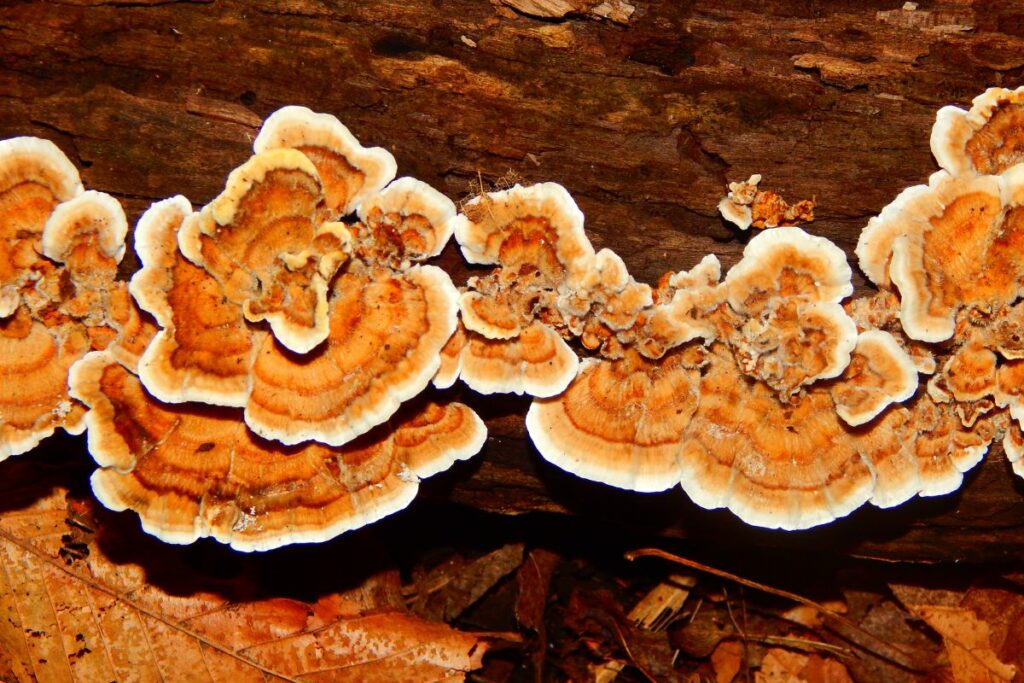
Turkey tail mushrooms (Trametes versicolor) are one of the most common types of mushrooms found in the wild. These distinctive mushrooms can be found across North America, in both deciduous and coniferous forests. Foragers interested in collecting turkey tail mushrooms should be aware of their unique characteristics to properly identify them before consuming or using them for medicinal purposes.
The best places to start looking for turkey tail mushrooms are on decomposing logs and stumps of hardwood trees such as oak, maple, and cherry. They may also be found on coniferous trees like fir and pine. These mushrooms usually grow in clusters, forming overlapping, bracket-like structures known as “shelf” or “bracket fungi.”
Turkey tail mushrooms are identifiable by their distinct fan-shaped or semi-circular shape, and concentric bands of color that range from cream to brown and even shades of blue or green. The upper surface of the mushroom has a velvety or slightly fuzzy texture, though it can become more leathery as it matures. The underside of the mushrooms is typically white or light cream with numerous tiny pores that release the spores.
When foraging for turkey tail mushrooms, it’s essential to be aware of look-alike species that may be potentially toxic or inedible. Some of the common look-alikes include the false turkey tail (Stereum ostrea) and the hairy parchment (Stereum hirsutum). These species lack the characteristic pores on the underside and may have a smooth or “hairy” texture, rather than the velvety texture found on true turkey tail mushrooms.
In addition to their potential medicinal benefits, foragers enjoy turkey tail mushrooms for their vibrant colors and their ability to blend into the natural surroundings, making them an exciting and rewarding find. Be sure to familiarize yourself with local regulations regarding wild mushroom collection and practice responsible foraging techniques to ensure the sustainability of these beautiful mushrooms for future generations to enjoy.
Medical Usage and Benefits
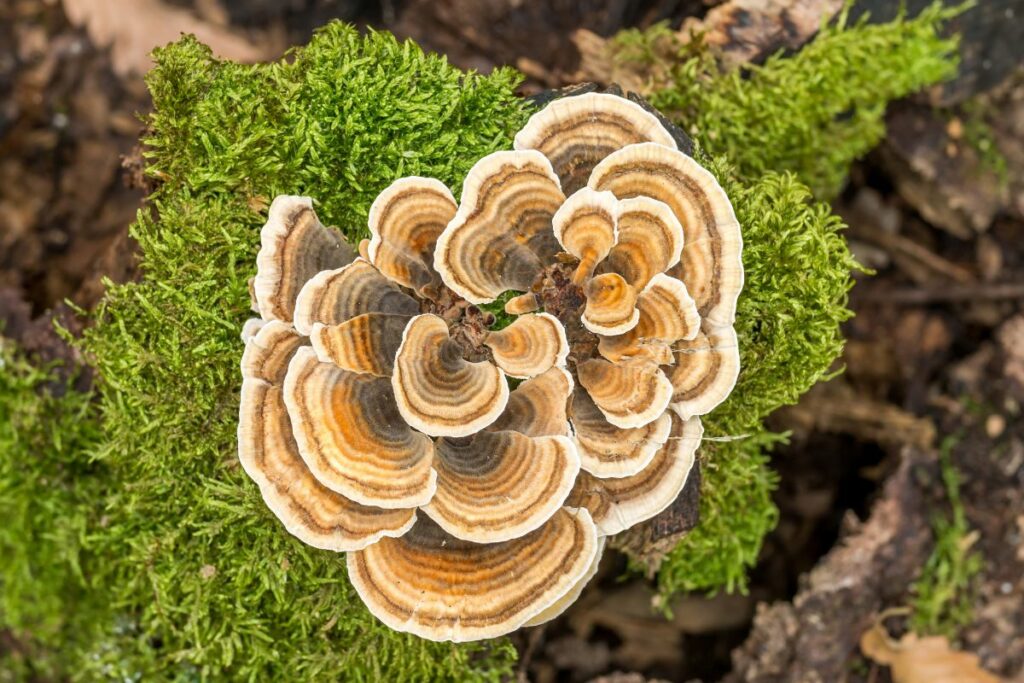
Turkey tail mushrooms, also known as Coriolus versicolor, have been used for centuries in traditional medicine, especially in Chinese medicine, for their various health benefits. These medicinal mushrooms are rich in polysaccharides, antioxidants, and other bioactive compounds that can contribute positively to one’s health.
One of the main health benefits of turkey tail mushrooms is their potential role in supporting the immune system. Research has shown that the polysaccharides found in these mushrooms, particularly PSK (polysaccharopeptide Krestin), can help enhance immune function and exhibit anti-tumor properties1. This has led to the use of mushroom extract supplements as a complementary therapy in cancer treatment2.
In addition to their immune-boosting properties, turkey tail mushrooms are also known for their digestive health benefits. The prebiotic nature of these mushrooms helps promote the growth of beneficial gut bacteria3, which can potentially aid in improving digestion and overall gut health.
Moreover, the antioxidant compounds present in turkey tail mushrooms can provide protection against oxidative stress and free radical damage4, which can contribute to the prevention of various chronic diseases. These antioxidants may also support a healthy inflammatory response and promote overall well-being.
Turkey tail mushrooms can be consumed in various ways, such as in the form of tea, capsules, or extracts. Turkey tail tea, for instance, is a popular choice for individuals looking to incorporate this mushroom into their daily routine for its health benefits5.
In conclusion, the turkey tail mushroom is a valuable medicinal mushroom with an array of health benefits, including immune support, digestive health, and antioxidant properties. Incorporating this mushroom into one’s diet or supplementation routine may offer potential health benefits and promote overall wellness.
Health Risks and Considerations
When foraging for turkey tail mushrooms, it is essential to be aware of the potential health risks and considerations. While turkey tail mushrooms (Trametes versicolor) have been known to possess medicinal properties, misidentification and improper handling could lead to detrimental health impacts. It is vital to consult a healthcare practitioner or trained mycologist to confirm the identification of the mushroom, as many look-alikes grow in the wild.
One common concern with foraging for turkey tail mushrooms is the possibility of mistaking them for poisonous species. Some toxic look-alikes include the false turkey tail (Stereum ostrea) and the hairy parchment (Stereum hirsutum). Consuming poisonous mushrooms can lead to severe gastrointestinal issues or, in rare cases, death. To minimize the risk of misidentification, it is crucial to be familiar with the distinguishing features of turkey tail mushrooms, such as their concentric, multicolored bands, and porous undersides.
Although turkey tail mushrooms have demonstrated potential in combating various diseases, they should not be solely relied upon as a cure or used as a substitute for medical advice. It is essential to consult a healthcare practitioner before incorporating turkey tail mushrooms into your diet or treatment plan, as they may interact with other medications or conditions. Also, potential side effects should be considered when ingesting these mushrooms, as some individuals may experience allergies or gastrointestinal discomfort.
Finally, it is important to consider the environment in which the mushrooms are growing. Turkey tail mushrooms may absorb pollutants and heavy metals from their surroundings, particularly if they are found near roads or industrial sites. Consuming contaminated mushrooms can pose additional health risks. Always ensure to harvest mushrooms from clean, unpolluted areas and properly clean them before consumption.
In conclusion, while turkey tail mushrooms offer potential health benefits, it is crucial to practice caution and seek professional guidance before including them in your diet or health regimen. Take care to correctly identify the mushrooms, consult a healthcare practitioner for advice, and be mindful of the environment when harvesting.
Additional Information
Turkey tail mushrooms, scientifically known as Trametes versicolor, are a type of polypore mushroom commonly found on dead or decaying wood. They are characterized by their distinctive fan-like appearance and contrasting color zones, which often include shades of brown, orange, and even white. These mushrooms are commonly referred to as the hairy bracket fungus in some regions.
The identification of turkey tail mushrooms is essential for those interested in their medicinal properties. In traditional Chinese and Japanese medicine, they are known as Yun Zhi and Kawaratake, respectively. These mushrooms have been extensively researched for their potential health benefits and have shown promise in supporting the immune system and digestive health.
When trying to identify turkey tail mushrooms, some key features to look for include their distinctive cluster formations and the contrasting color zones on their upper surface. A good resource for distinguishing turkey tail mushrooms from other Trametes species is the website MushroomExpert.com. One key aspect to consider when identifying turkey tail mushrooms is their pore size. The pores of Trametes versicolor are usually small enough to require a magnifying glass or the tip of a ballpoint pen to determine their size accurately.
It is essential to mention that although turkey tail mushrooms have been studied extensively for their medicinal properties, they are not approved by the FDA to treat any medical condition. As a result, it is crucial to consult with a healthcare practitioner before using them for their potential health benefits.
In conclusion, turkey tail mushrooms are a fascinating species of polypore mushrooms with a history of traditional medicinal use. Proper identification is necessary to distinguish them from closely related Trametes species, such as Trametes pubescens. Utilizing resources like MushroomExpert.com and consulting with a healthcare practitioner can ensure proper identification and safe use of these mushrooms.
Frequently Asked Questions
What are the key features to differentiate Turkey Tail from its look-alikes?
Turkey Tail mushrooms (Trametes versicolor) are characterized by their colorful, fan-shaped, and concentrically zoned fruiting bodies. Look for the following features to differentiate them from their look-alikes:
- Color: They often display a variety of colors, including shades of brown, gray, blue, and green.
- Size: Generally, Turkey Tail mushrooms are small to medium-sized, with their caps measuring 2-10 cm wide.
- Shape: Caps are semicircular, fan-like, or kidney-shaped, and are thin and flexible.
- Texture: They have a velvety texture, with hairy upper surfaces and smooth undersides.
- Hymenophore: The undersurface features tiny, white, circular pores called the hymenophore. The pore size is essential in differentiating between Turkey Tail and its look-alikes.
How can I recognize edible Turkey Tail mushrooms from the poisonous ones?
Turkey Tail mushrooms are not known to be toxic, and they have been used for medicinal purposes for centuries. However, their look-alikes can be potentially toxic. Identifying edible Turkey Tail mushrooms involves checking for the specific characteristics mentioned above and comparing them with images and descriptions found in reputable sources.
What are the most common Turkey Tail mushroom look-alikes to be aware of?
The most common look-alikes include:
- Stereum ostrea: Also known as False Turkey Tail, this mushroom has a smooth and crust-like underside instead of pores.
- Trichaptum biforme: Known as Violet Tooth Polypore, this species usually has a purple or violet hue on the pore surface.
Educate yourself on the differences between these look-alikes and genuine Turkey Tail mushrooms to avoid confusion.
How can I use the underside of a mushroom to confirm if it is Turkey Tail?
Examining the underside of a mushroom is crucial in the identification process. Turkey Tail mushrooms have a pore surface on the underside, featuring tiny, round, white or cream-colored pores. These pores are typically 1-3 mm in diameter, packed close together. If the underside of the mushroom has no pores or displays different characteristics, it is likely a look-alike and not a genuine Turkey Tail.
What distinguishes Turkey Tail fungi from other similar species?
The main feature that distinguishes Turkey Tail mushrooms is their pore surface (hymenophore) found on the underside. The presence of tiny, round, white or cream-colored pores, in conjunction with the colors, shape, and texture of the upper surface, sets Turkey Tail fungi apart from similar species.
Are there any noticeable differences between Old and White Turkey Tail mushrooms?
Although “Old Turkey Tail” and “White Turkey Tail” are not distinct species, the names could refer to age- or weather-related variations in Turkey Tail mushrooms’ coloration. Older or weathered specimens can appear faded, mainly displaying white or cream tones rather than the vibrant colors found in younger or fresher samples. It is important to remember that coloration alone is not sufficient to identify Turkey Tail; always consider the characteristics of the pore surface and other features for proper identification.
Footnotes
- https://www.dl.begellhouse.com/journals/708ae68d64b17c52,1b1b20957ef5c8f4,210d57c00e88b78c.html ↩
- https://www.liebertpub.com/doi/abs/10.1089/act.2007.13410 ↩
- https://link.springer.com/article/10.1186/s12906-019-2681-7 ↩
- https://www.dl.begellhouse.com/journals/708ae68d64b17c52,3d8e7b4f6342518e,4675f12b644a5c81.html ↩
- https://www.sciencedirect.com/science/article/pii/S0753332223002123 ↩

